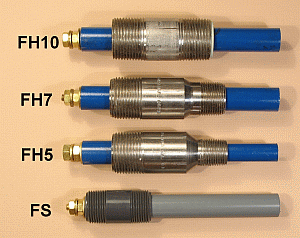Through Wall Reference Electrodes
Through-wall reference electrodes are used for measuring corrosion potential on the inside of condenser waterboxes, circulating pipes, tanks and vessels. These electrodes are installed by threading into a tapped hole on the wall; a junction box is typically attached to the other end to protect the wiring connections. Through-wall reference electrodes can be ordered with any of the sensing elements listed in the adjacent sidebar.

The Standard Probe (Model FS) uses a CPVC extension tube and a � inch NPS PVC nipple for attachment. It can be used at pressures up to 40 psi (270 kPa) and intermittent temperatures up to 180°F (82°C). The Heavy Duty Probe (Model FH) has a glass reinforced epoxy (G-10 GRE) extension tube and a 316L stainless steel nipple. It can be used at pressures up to 75 psi (0.5 MPa) and intermittent temperatures up to 210°F (98°C). Model FH is available in three size variations: Model FH10 is threaded into a 1 inch NPT hole, Model FH7 is threaded into a 3/4 inch NPT hole, Model FH5 is threaded into a 1/2 inch NPT hole; all three variations have a 1 inch NPT thread on the termination side.
The temperature limits stated are those for the wetted materials of construction. Through-wall reference electrodes should generally not be continuously used at temperatures exceeding 110°F (45°C) because the reference potential will be significantly different from its value at ambient temperature and the electrode service life will be drastically shortened. The product will survive occasional brief temperature excursions up to the limits stated in the preceding paragraph. For applications involving continuous exposure to temperatures over 110°F (45°C), our Process Vessel Reference Electrode is recommended.
Element Selection Guide
EDI reference electrodes may be ordered with any of five different reference elements. The element selected depends upon the electrolyte in which the electrode is used.
Gelled copper/copper sulfate elements (EDI code CUG) are typically used in environments with less than 500 ppm chloride or other halides. They consist of high purity metallic copper immersed in a saturated CuSO4 solution containing a gelling agent. Use of these elements in electrolytes with higher halide levels or in electrolytes with any sulfides present will contaminate the element causing its reference potential to drift. Because of their widespread use, Cu/CuSO4 electrodes are the ones upon which many cathodic protection criteria are based. Cu/CuSO4 elements are available in all EDI product groups except Concrete Products.
Gelled silver/silver chloride elements (EDI code AGG) can be used in any environment which does not contain sulfides. They consist of 99.99% pure silver coated with silver chloride and immersed in a saturated potassium chloride solution containing a gelling agent. The reference potential of Ag/AgCl/sat. KCl elements is 105 mV negative to that of a saturated Cu/CuSO4 reference electrode. Ag/AgCl/sat. KCl elements are available in all EDI product groups.
Dry silver/silver chloride elements (EDI code AGD) are most commonly used in clean full strength seawater where the electrolyte comes into direct contact with the element. Like the gelled Ag/AgCl elements, they are adversely affected by sulfides. The reference potential of dry Ag/AgCl elements immersed in full strength seawater is 70 mV negative to that of a saturated Cu/CuSO4 reference electrode. As the ambient chloride level decreases, as would be the case when used in brackish water, the reference potential becomes less positive. Dry Ag/AgCl elements are only available in our through-wall, immersion and tubesheet mounted reference electrodes.
Dry silver/silver chloride elements for concrete (EDI code AGC) is a variation of our standard dry Ag/AgCl element which has been adapted for encasement in a cement-based grout. The reference potential depends on the pore water chloride level of the concrete structure in which it is embedded. This element is only available in our Marine Concrete reference electrode, EDI Model CM-AGC.
Zinc elements (EDI code ZIN) consist of high purity metallic zinc rod. When these elements are used in our underground reference electrodes, the zinc element is encased in a gypsum-bentonite backfill. The zinc element is directly wetted by the electrolyte in our through-wall and immersion reference groups. Reference potential of a zinc element encapsulated in backfill is about 1,100 mV negative to that of a saturated Cu/CuSO4 reference electrode. The reference potential of zinc directly exposed to an electrolyte depends on the composition of the electrolyte.
Design Life
The design life of a reference electrode is an estimate of the time based on test results it would take for enough salt to diffuse out from the inner core to lower the salt concentration to below saturation. At EDI, we use several techniques to extend this time as much as possible. One of these techniques is to increase the amount of salt reserve contained in the gel. This is one reason why longer life electrodes have physically bigger housings. Download our paper Factors Affecting the Accuracy of Reference Electrodes to learn more.
For More Information
Complete Product Information is available for downloading as pdf files. Click on the link below to download.
Standard Probe (Model FS).
Heavy Duty Probe (Model FH).
EDI products may be purchased from any corrosion control products distributor or directly from EDI.
